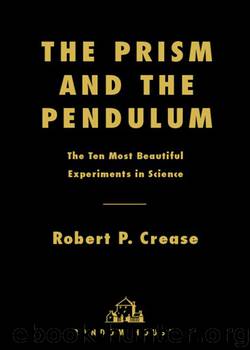The Prism and the Pendulum by Robert Crease

Author:Robert Crease
Language: eng
Format: epub
Tags: Science
ISBN: 9780307432537
Publisher: Random House Publishing Group
Published: 2007-12-17T16:00:00+00:00
Interlude
SCIENCE AND METAPHOR
YOUNG’S EXPERIMENT, whose beauty stems from the clarity with which he made one phenomenon—light—show itself acting like another—waves—is a classic example of the successful use of analogy in science. But analogy (from the Greek for “proportionate”) and metaphor (a figure of speech by which one thing is spoken of as if it actually were another, from the Greek for “carrying further”) can also mislead and interfere with thought. For this reason scientists are of two minds, so to speak, about their value.1
Some find analogies and metaphors distracting at best, confusing at worst. “When thinking about nature,” the biologist Richard Lewontin once wrote, “beware of metaphors.” Physicist Ernst Mach thought it useful to be able to say that “the fact A now considered comports itself . . . like an old and well-known fact B,” but denied such assertions played a structural role in science. Like Mach, Pierre Duhem, a physicist and historian of science, regarded metaphors and analogies as important psychological, explanatory, and educational tools. But, Duhem insisted, real science eventually discards them.
Metaphor-users and analogists, in this view, play Aaron to Moses. Just as the prophet Moses wrested knowledge from the beyond, which his brother and spokesman Aaron, a careful listener who dwelt more intimately in the community, then transmitted to the masses, so scientists discover truths about nature, which educators, popularizers, and journalists interpret for novices and the public using imagery and everyday language. The anti-metaphorists and anti-analogists view them as having a place in this secondary process involving the dissemination and transmission of information, but not in the primary discovery process itself. Science, real science, is about what something is, not what it’s like.
Others, however, find metaphors and analogies to be so deeply woven into scientific thought as to be practically indispensable. “It is probably no exaggeration to say,” remarks physicist Jeremy Bernstein, “that all of theoretical physics proceeds by analogy.” Writes physicist John Ziman, “We cannot think about anything, except by analogy and metaphor.” The pro-metaphorists and pro-analogists claim that whenever scientists say what something is, they are also, inevitably, saying what it’s like and what’s like it.
This kind of conflict—where opposing armies mass on either side of a seemingly clear and intractable boundary—can be resolved by philosophy, whose role is to detect and expose the confusions and ambiguities that make such boundaries seem intractable in the first place. In the case of metaphors in science, a philosopher would instinctively point out that not all metaphors work in the same way, or for the same reason. Metaphors in science, in fact, work in at least three different ways.
A first use of metaphor is as a filter. Consider classic metaphors such as “man is a wolf ” or “love is a rose.” In these, what is known as the “secondary subject”—wolf, rose—calls the reader’s attention to certain conventionally understood features of these subjects (solitary and predatory in the case of the wolf; pretty but thorny for the rose). The goal in both cases is to illuminate those aspects in the “primary subject”—man or love—and filter out, as it were, the rest.
Download
This site does not store any files on its server. We only index and link to content provided by other sites. Please contact the content providers to delete copyright contents if any and email us, we'll remove relevant links or contents immediately.
| Electron Microscopes & Microscopy | Experiments & Projects |
| Measurement | Microscopes & Microsocopy |
| Scientific Instruments | Telescopes |
| Time | Methodology & Statistics |
Hands-On Genetic Algorithms with Python by Eyal Wirsansky (2020) by Unknown(4085)
Thing Explainer by Randall Munroe(3909)
The Elements by Theodore Gray(3025)
The Meaning of it All by Richard Feynman(2318)
Make by Mike Westerfield(2303)
Every Tool's a Hammer by Adam Savage(1913)
Science Experiments You Can Eat by Vicki Cobb(1855)
The Perfectionists by Sara Shepard(1803)
Martin Gardner's Science Magic by Martin Gardner(1707)
Raspberry Pi Electronics Projects for the Evil Genius (Tab) by Norris Donald & Norris Donald(1687)
Elephants on Acid by Boese Alex(1578)
Elephants on Acid: And Other Bizarre Experiments by Alex Boese(1575)
The Perfectionists by Simon Winchester(1572)
Handbook of Modern Sensors by Jacob Fraden(1559)
Synchrotron Light Sources and Free-Electron Lasers by Eberhard J. Jaeschke Shaukat Khan Jochen R. Schneider & Jerome B. Hastings(1537)
Tesla by Carlson W. Bernard(1502)
The Science of Food by Marty Jopson(1463)
125 Physics Projects for the Evil Genius by Silver Jerry(1430)
The Meaning Of It All by Richard P. Feynman(1430)
